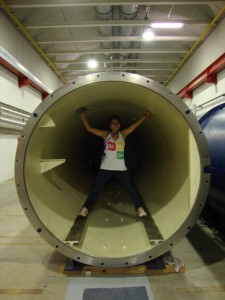This story by Sam Roberson, staff writer for The Technician, was originally published in The Technician on March 17, 2015.
The exchange of knowledge through time is characterized by the allusion of “The Great Conversation.” In the scientific community, the process of discovery and adding to this “conversation” can at times feel more like a great argument.
Mia de los Reyes ’16, a junior studying both math and physics, found this was the case when she embarked on a research assignment on galaxy evolution that led to her publishing a research paper in the Astronomical Journal, a prominent astronomy journal. The summer after her freshman year, de los Reyes worked in the Space Telescope Science Institute in Baltimore, Maryland, specifically the science center for the Hubble telescope.
“The assignment was supposed to be an easy undergrad project,” de los Reyes said.
What unfolded as she got further into the project proved to be a controversial finding. De los Reyes’ research looked at similar properties between galaxies, seeking to better understand how a younger galaxy forms.
“One way to study galaxy evolution is to measure galaxy properties at different ages of the universe to understand how they evolve over time and in relation to one another,” de los Reyes said. “We can do this because the speed of light is finite, so looking farther away in space is the same as looking back in time.”
Reyes examined data from galaxy observations, which allowed her to look at the star mass, amount of metal in a galaxy and star formation rate. A correlation between two variables of star mass and metal or star mass and formation rate has been well-studied in the past. Recently, astronomers have sought to research a correlation with all three properties to see if a fundamental relationship among the three properties exists.
“We found that all of our relations were consistent with previous literature, but our relation between all three was statistically vague; that is, we couldn’t determine whether a dependence on star formation rate existed or not,” de los Reyes said.
What this could mean is that recent studies on a fundamental relationship among all three properties needs to be revisited and more data is needed before any conclusive statements are made on how galaxies evolve. A bold conclusion to be reached by a 19 year old in a summer research program.
“Within people who study galaxy evolution, this is pretty controversial,” de los Reyes said. “When we first started we didn’t think it would be this controversial.”
Entering the summer program, de los Reyes had some experience from the astrophysics department at NC State, but she had to do reading before coming to the institute to actually be able to analyze the data.
“I would read papers, and every single word I didn’t know, I would underline and ask my advisers about it,” de los Reyes said.
In the regard that these undergraduates are learning on the job, it seems hard to accredit their research findings on account of inexperience.
However, Stephen Reynolds, a distinguished professor of astrophysics at State, said that undergraduate students at NC State have learned to analyze data from computer simulations or satellites in a matter of weeks.

“The tricky part is finding ways that smart, eager, but inexperienced, students can contribute,” Reynolds said. “Both types of work [Computer simulation and satellite] have resulted in publications including undergraduate co-authors in the last few years.”
After a research process that was supposed to be finished within five months, de los Reyes’ project ended up taking more than a year and running well into the next summer before the paper was published.
“Our reviewer was at first not happy with our work,” de los Reyes said. “We had to appease him by using methods he liked or citing a paper he agreed with.”
It may come as a shock to many that the scientific world, often thought of a realm of pure reason, can be almost political with competing views and research teams battling for the right to be acknowledged and published.
“It surprised me a lot, realizing science is done by humans,” de los Reyes said.
With de los Reyes’ paper published, the process will continue with others critiquing her work and comparing their own findings. She said she has gotten feedback from astronomers around the world and further studies examining her research are already being carried out.
posted 2015.03.19
